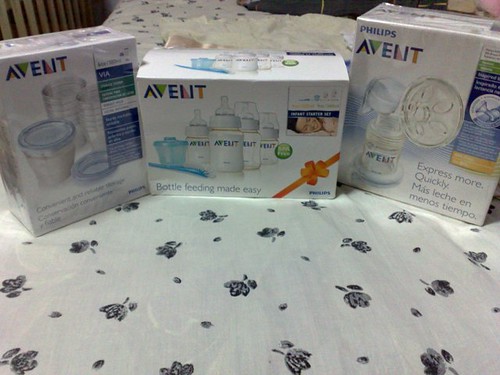Most mothers would like to breastfeed their babies for a long time, even after returning to work upon expiration of their maternal leaves. This breastfeeding month, let’s support and celebrate our fellow breastfeeding at work mothers who choose to be mom first even while working.
If you are a breastfeeding mom about to return to work, I hope these information relieves some of your worries and give you an idea to create your own post-maternity leave breastfeeding routine:
1. Using a good, electric breast pump – mothers only require 15 minutes every 3-4 hours to complete milk extraction.

This is a picture of my manual breast pump in 2010. I had to ask my mother-in-law in the US to buy it for me. Read about it here.
Now you can easily get electric/automatic versions like this in shopping malls.
2. Failure to pump and holding on to breast milk can cause mastitis which can cause pain, fever and even infection. Missing out on pump time will make your milk disappear.
3. Breastfeeding at work and/or using your breast pump at work is a Human Right. If your employer asks, please point them to RA 10028 which was approved in March 2010 called the Expanded Breastfeeding Act.
- Private enterprises as well as government agencies, including government-owned and controlled corporations, are required to put up lactation stations.
- Expenses incurred by private health and non-health facilities, establishments or institutions in complying with the law will now be deductible expenses (for income tax purposes) that can be up to twice the actual amount incurred.
- The law requires “lactation periods” for breastfeeding employees, in addition to time-off for meals, to allow them time to express their breast milk. This period should be less no less than a total of 40 minutes for every eight-hour working period.
4. Extracting your milk and continuous breastfeeding releases oxytocin “the happy hormone” which can help you become happier at work and increase your productivity.
5. Continuous breastfeeding vs. bottle feeding saves you Php 50,400 every 6 months as well as help the environment.
Communication with your employer is key:
1. Express your need to continue breastfeeding, its benefits for you, the baby, and the company.
2. Breastfeeding will help your child avoid illness, thus avoiding employee absence on your part. Breast milk is the gold standard providing your child with antibodies, higher vitamin E content, iron, fat, protein, and so much more.
3. Express your need to use the breast pump for 15 minutes, every 3-4 hours.
4. Request for a spare room to be converted into a breastfeeding room. This should be a small, clean, quiet place, with electrical outlet, a chair and table, and a door that locks.
Philips, the company behind Avent has this breastfeeding room in their Philippine office. Use these photos for inspiration and you can even replicate this room at home or in your bedroom:
The company strongly advocates Breastfeeding at the Workplace.
5. Highlight that breastfeeding moms need understanding in the workplace. My personal suggestion is to discuss your breastfeeding plans and needs during your first day back at work, with your employers and fellow employees. Or, before you take your maternal leave as most workplaces offer small gatherings like baby showers. This might be a good venue to have an open communication about breastfeeding.
Always remember that there is nothing selfish about returning to work. In fact, it is the most self-less gesture. In my opinion, every mom wants to be with their child 24/7 and working mothers sacrifice a lot in order to provide only the best for their family.
Happy breastfeeding month mommies! I am proudly breastfeeding for 5 years now and with this comes challenges i.e. crude jokes from family members directed to me and my son. Our decision on extended breastfeeding is supported by research and personal encounters with moms and breastfeeding experts who breastfed up to 6 years of age.
Whenever someone comments or questions you about your breastfeeding goals, remember that you are not doing this for them but for you and your baby.